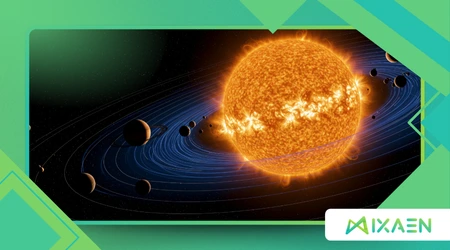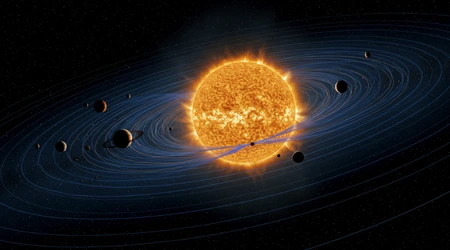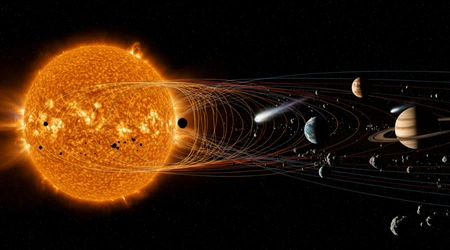How the Sun’s Magnetic Field Shapes the Entire Solar System

The Sun’s Magnetic Field Shapes the Entire Solar System, orchestrating a cosmic dance that influences planets, comets, and even spacecraft.
Anúncios
This invisible force, generated deep within the Sun’s core, extends far beyond its fiery surface, sculpting the environment of our solar system with a power both subtle and immense.
Unlike a static magnet, the Sun’s magnetic field is dynamic, flipping every 11 years in a cycle that drives solar phenomena like sunspots, flares, and coronal mass ejections (CMEs).
These events ripple outward, impacting everything from Earth’s auroras to the trajectories of distant asteroids.
In 2025, as we approach the peak of Solar Cycle 25, understanding this magnetic influence feels more urgent than ever. Why?
Because its effects touch our technology, climate, and even our aspirations for space exploration. This article dives into the mechanics of the Sun’s magnetic field, its far-reaching effects, and why it matters to us all.
The Sun’s magnetic field isn’t just a local phenomenon it’s a galactic architect. Its reach extends to the heliopause, roughly 120 astronomical units away, where the solar wind meets interstellar space.
This field governs the heliosphere, a protective bubble shielding our solar system from cosmic rays. But how does it work, and why should we care?
Let’s explore the mechanisms, impacts, and mysteries of this solar force, with real-world examples and current insights to illuminate its role.
The Engine of the Sun’s Magnetic Field
Deep within the Sun, a turbulent process called the solar dynamo generates its magnetic field. Plasma churns in the convective zone, twisting magnetic lines into complex patterns.
This dynamo, driven by the Sun’s rotation, creates a field that’s anything but uniform it’s a chaotic web of loops and knots.
Every 11 years, the field reverses polarity, a cycle tracked by NASA since the 1950s. During Solar Cycle 25’s peak in 2025, sunspot activity is expected to intensify, amplifying magnetic effects.
This dynamic field doesn’t stay confined to the Sun. It stretches outward via the solar wind, a stream of charged particles carrying magnetic energy.
These particles interact with planetary magnetospheres, shaping their behavior. For instance, Jupiter’s magnetic field, influenced by the Sun, creates intense radiation belts.
The Sun’s Magnetic Field Shapes the Entire Solar System by dictating these interactions, acting like a conductor leading a cosmic orchestra.
++ Solar Tornadoes: What They Are and Why They Matter
But the field’s influence isn’t always predictable. In 2024, a study in Nature Astronomy revealed that magnetic reconnection events where field lines snap and realign can trigger unexpected solar flares.
These events disrupt the heliosphere’s balance, sending shockwaves that affect distant objects. Understanding this process is crucial for predicting space weather, which impacts satellites and astronauts.
The dynamo’s complexity also fuels solar mysteries. Why do some cycles produce more sunspots than others? Scientists are still unraveling the interplay of plasma flows and magnetic turbulence.
Advances in heliophysics, like data from the Parker Solar Probe, are shedding light on these questions, bringing us closer to decoding the Sun’s magnetic heart.

The Heliosphere: A Magnetic Shield
The heliosphere, shaped by the Sun’s magnetic field, is a vast bubble enveloping our solar system. It protects planets from galactic cosmic rays, high-energy particles from distant stars.
The Sun’s Magnetic Field Shapes the Entire Solar System by defining this shield’s boundaries, which extend beyond Pluto to the heliopause.
Voyager 1, crossing this boundary in 2012, confirmed the field’s reach, detecting a sharp drop in solar wind particles.
This magnetic shield isn’t static. During solar maximum, like in 2025, the field strengthens, compressing the heliosphere’s edge.
Also read: The Parker Solar Probe: Flying Into the Heart of Our Star
Conversely, during solar minimum, it weakens, allowing more cosmic rays to penetrate. These rays can damage spacecraft electronics, as seen in a 2019 incident when a cosmic ray surge disrupted a Mars rover’s sensors. The heliosphere’s shape thus directly affects space exploration safety.
Planets also feel this influence. Earth’s magnetosphere, for example, interacts with the solar wind, creating auroras when charged particles hit atmospheric gases.
In 2023, a powerful CME triggered auroras visible as far south as Arizona, a rare event tied to the Sun’s magnetic activity. This interplay highlights the field’s role in shaping planetary environments.
But the heliosphere isn’t flawless. Cosmic rays still leak through, especially during solar minimum, posing risks to DNA and electronics.
Researchers are studying how these leaks vary with solar cycles, using data from the European Space Agency’s Gaia mission to map cosmic ray patterns. The heliosphere’s protective role is a testament to the Sun’s magnetic dominance.
Solar Storms and Technological Impacts
When the Sun’s magnetic field twists, it unleashes solar storms flares and CMEs that hurl charged particles across the solar system.
These storms, driven by the Sun’s Magnetic Field Shapes the Entire Solar System, can disrupt Earth’s technology.
In 1989, a CME caused a blackout in Quebec, affecting 6 million people for 9 hours. Such events are more frequent during solar maximum, like now in 2025.
Satellites are particularly vulnerable. A 2022 solar storm damaged 40 Starlink satellites, costing SpaceX millions. The Sun’s Magnetic Field Shapes the Entire Solar System by dictating these events’ intensity, as magnetic reconnection fuels CMEs.
Operators now use predictive models, like those from NOAA’s Space Weather Prediction Center, to mitigate risks.
Read more: How NASA Is Studying the Sun Without Getting Burned
Astronauts face dangers too. Solar storms increase radiation exposure, threatening missions to the Moon or Mars.
NASA’s Artemis program, planning lunar landings in 2026, incorporates magnetic field data to schedule safe launch windows. This shows how solar activity shapes space exploration strategies.
Ground-based systems aren’t immune either. Power grids, GPS, and aviation systems can falter during geomagnetic storms.
In 2024, a storm disrupted GPS signals over the Arctic, affecting transpolar flights. As our reliance on technology grows, understanding the Sun’s magnetic influence becomes critical for resilience.
The Far-Reaching Effects on the Outer Solar System
Beyond the inner planets, the Sun’s magnetic field continues to exert influence. Comets, for instance, develop glowing tails as solar wind particles strip their material.
The Sun’s Magnetic Field Shapes the Entire Solar System by guiding these tails, which always point away from the Sun, as seen in Comet NEOWISE’s 2020 display. This interaction reveals the field’s reach to distant regions.
Asteroids, too, are affected. Charged particles from the solar wind can alter their surfaces, a process called space weathering.
A 2023 study of asteroid Bennu, sampled by NASA’s OSIRIS-REx, showed magnetic-induced erosion on its surface. This subtle effect reshapes our understanding of asteroid evolution.
The Kuiper Belt and Oort Cloud, home to comets and dwarf planets, also feel the Sun’s magnetic touch. The solar wind sculpts these regions, influencing object orbits.
Data from the New Horizons mission, exploring the Kuiper Belt since 2015, suggests magnetic field variations affect dust particle dynamics, impacting future missions.
Even interstellar visitors, like ‘Oumuamua in 2017, interact with the Sun’s magnetic field. As these objects pass through the heliosphere, solar wind alters their trajectories. This dynamic underscores the field’s role in shaping the solar system’s boundaries and beyond.
The Sun’s Magnetic Field and Climate Connections
Could the Sun’s magnetic field influence Earth’s climate? While the Sun’s energy output drives climate, its magnetic field plays a subtler role.
The Sun’s Magnetic Field Shapes the Entire Solar System, including Earth’s atmospheric processes, by modulating cosmic rays. These rays can seed cloud formation, potentially cooling the planet.
A 2016 study in Science found that during solar minimum, increased cosmic ray influx correlates with slight cloud cover increases.
This effect, though small, could influence global temperatures over centuries. For example, the Maunder Minimum (1645–1715), a period of low solar activity, coincided with cooler European climates, though direct causation remains debated.
Today, as we monitor Solar Cycle 25, scientists use satellites like SOHO to track magnetic field changes.
These changes could subtly affect weather patterns, though human-driven climate change far outweighs solar impacts. Still, understanding these connections refines climate models.
The interplay extends to other planets. Mars, with its weak magnetic field, relies on the Sun’s field to deflect some cosmic rays.
Data from the MAVEN mission shows how solar wind strips Mars’ atmosphere, a process intensified during solar storms. This highlights the Sun’s magnetic role in planetary habitability.
Future Implications for Space Exploration

As humanity eyes Mars and beyond, the Sun’s magnetic field looms large. Its influence on space weather dictates mission safety and success.
The Sun’s Magnetic Field Shapes the Entire Solar System, affecting spacecraft navigation and communication. For instance, solar storms can disrupt radio signals, as seen in a 2023 Mars rover glitch.
Future missions must account for these effects. The European Space Agency’s JUICE mission, launched in 2023 to study Jupiter’s moons, uses magnetic field models to protect its instruments.
Similarly, lunar bases planned for the 2030s will need shielding from solar radiation spikes.
An analogy helps here: the Sun’s magnetic field is like an ocean current, guiding ships (spacecraft) while occasionally stirring storms.
Navigating it requires precise forecasting, which is improving with AI-driven models. In 2025, SpaceX uses such tools to time Starship launches, avoiding solar storm peaks.
Exploration also drives scientific discovery. The Parker Solar Probe, diving into the Sun’s corona, has revealed magnetic switchbacks sudden field reversals that could improve space weather predictions. These insights will shape how we explore the solar system’s farthest reaches.
Table: Key Effects of the Sun’s Magnetic Field
| Phenomenon | Effect | Example |
|---|---|---|
| Solar Wind | Carries magnetic field, shapes heliosphere | Influences comet tails (NEOWISE) |
| Solar Storms (CMEs) | Disrupts technology, increases radiation | 1989 Quebec blackout |
| Cosmic Ray Modulation | Affects cloud formation, spacecraft safety | 2019 Mars rover sensor damage |
| Planetary Magnetospheres | Creates auroras, protects atmospheres | 2023 Arizona auroras |
This exploration of how the Sun’s Magnetic Field Shapes the Entire Solar System reveals its profound influence, from Earth’s auroras to distant comets.
As we venture deeper into space, understanding this force is vital. What will the next solar cycle reveal about our cosmic home?
The Sun’s magnetic field holds the answers, guiding our journey through the stars.
Frequently Asked Questions
How does the Sun’s magnetic field affect Earth’s technology?
It triggers solar storms, disrupting satellites, power grids, and GPS, as seen in the 1989 Quebec blackout.
Can the Sun’s magnetic field influence climate?
Yes, indirectly, by modulating cosmic rays that may seed clouds, though human activity drives most climate change.
Why does the Sun’s magnetic field flip every 11 years?
The solar dynamo, driven by plasma motion, reverses the field, creating the 11-year solar cycle.
How far does the Sun’s magnetic field extend?
It shapes the heliosphere, reaching the heliopause, about 120 astronomical units from the Sun.
